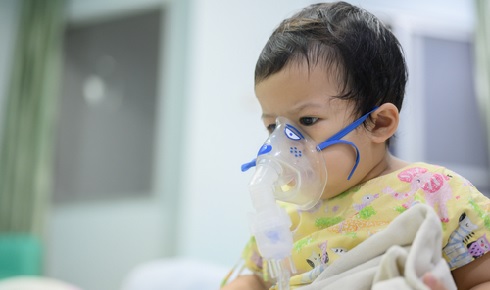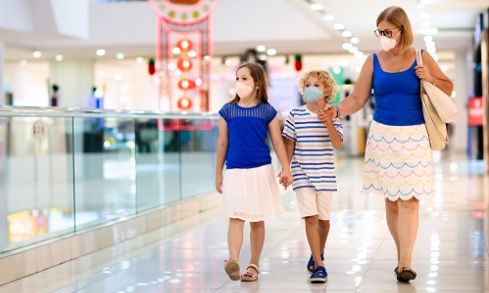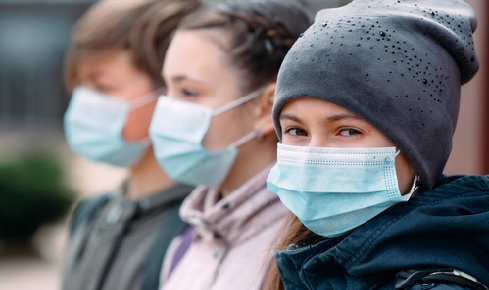The parallel pandemics

Paediatrician Dr Thomas Williams looks at how measures designed to restrict the spread of COVID-19 are causing unpredictable disease dynamics in common childhood respiratory diseases such as RSV
9th December 2021
In recent years a paradox has emerged in child health in developed countries. Due to the widespread adoption of effective vaccines, children have never been safer, yet the number of hospital emergency consultations and admissions grows year on year.
The reason for this is complicated and multifactorial. Even though the incidence of disease has fallen, as a society we are more risk averse, and infants and children who a few decades ago would likely have been seen by GPs or emergency physicians and discharged, or not even been taken to a medical professional, are now being admitted for a short period of observation.
In Scotland, for example, the number of infants with bronchiolitis (a viral lower respiratory tract infection) being admitted for a day or less doubled from 2011 to 2016; and in England the number of admissions for lower respiratory tract infections increased between 2016 and 2019[1].
The most significant cause of these infections is one in which I have had a research interest for several years: respiratory syncytial virus (RSV).
RSV is caused by an RNA virus that leads to respiratory tract infections of either the upper (runny nose and cough) or lower respiratory tract (a chest infection, most commonly referred to as bronchiolitis). It is is spread most commonly through airborne droplets or via contaminated hands and may account for a fifth (22%) of all episodes of acute lower respiratory tract infection in children globally [2].
It is the most common cause of bronchiolitis in infants and young children, and the most significant disease in those under three months old. An estimated 5.8% of infants under the age of one are admitted with bronchiolitis in England; of these a small minority will require admission to an intensive care unit for respiratory support, sometimes intubation and mechanical ventilation. RSV causes annual epidemics in temperate countries in autumn/winter, associated with an increase in emergency department attendances and admissions.
Another significant cause of hospital admissions are preschool children admitted with wheeze triggered by a viral infection – the most common cause being rhinovirus, and in particular a strain called rhinovirus C. The start of term at the end of summer is associated with an increase in wheeze cases as rhinovirus starts to circulate in nurseries and schools.
The calm before the storm?
So what has happened during the COVID-19 pandemic? SARS-CoV-2 first emerged as a public health threat at the end of December 2019. By February/March 2020 most countries had introduced measures such as travel restrictions, school and workplace closures, and the introduction of masks to try to reduce its spread. It turned out that these measures were also highly effective in reducing the spread of other pathogens.
In Scotland we conducted a research study to look at the impact of COVID-19 distancing measures on childhood disease, and found a reduction in emergency department attendances, and hospital and intensive care admissions[3]. The greatest reduction in paediatric intensive care unit admissions was for diseases of the respiratory system; those for injury, poisoning or other external causes were equivalent to previous years.
Interestingly there was no decrease in deaths. We found that this was because infectious diseases are now a rare cause of death in children - the most common cause is now the complications of preterm births. This suggests that reducing the number of childhood deaths further will require substantial effort to try to modify factors associated with increased rates of preterm birth: deprivation, socioeconomic inequality, and factors such as smoking and drug and alcohol misuse[4].
 For a time, COVID-19 mitigation measures helped reduce rates of common diseases such as RSV to virtually zero
For a time, COVID-19 mitigation measures helped reduce rates of common diseases such as RSV to virtually zeroToo good to be true?
The usual autumn/winter epidemic of RSV in June/July/August 2021 in southern hemisphere countries just didn’t materialise. Similarly, in the northern hemisphere, in countries such as the UK where rates would normally start picking up in October/November, there was no such spike. In fact, there was hardly any RSV infection at all[5].
These quiet few months showed us two things. First, that it is possible to reduce the rates of these common conditions: the social distancing measures introduced to limit COVID-19 essentially eliminated RSV. Whether this is due to reduced import of the virus due to less global travel and enforced quarantine, or a reduction in the spread of the virus due to measures such as school bubbles, increased hand-washing or mask wearing, is hard to say.
The second learning point is that decreasing the burden of these diseases has significant economic and societal benefits: over this period fewer hospital beds, fewer intensive care beds, and fewer days off work for parents were required. However, as with many good situations, it seemed a little too good to be true, and this is what we have found to our cost this summer.
Australia did see an RSV season six months later than it normally would, occurring in the middle of their summer (December 2020/January 2021). Case numbers surged, with admission rates higher than would normally be seen during winter periods (June–August). Then in most European countries a delayed RSV season began in spring 2021. In the US, the Centers for Disease Control and Prevention also reported an increase in RSV activity in May to June 2021, which is unusual for this time of year.
The delayed epidemiological peaks of RSV (and other respiratory illnesses such as influenza) observed have created uncertainties around preparedness and the management of resources. For countries that have experienced an entire year without RSV or influenza, mathematical modelling suggests the possibility of a hard rebound, marked by increased morbidity and mortality from one or both viruses in the winter of 2021/2022.
Transmission dynamics
In the UK, aware of what had happened in Australia at the end of 2020, we set up a research study (BronchStart)[6] to look at the RSV pandemic this year. We’re recruiting infants and children who present to emergency departments across the UK and Ireland to look at patterns of presentation and clinical features of those patients.
We’ve found that in England we had a late but smaller than usual season, which peaked in July/August; in Scotland cases started a bit later, but again now appear to be falling again. This data will help us understand how different this year’s RSV season is to previous years’, and inform service provision, public health planning and RSV vaccine implementation. We’ll be publishing our initial clinical data soon, but in the meantime you can explore the temporal and geographic patterns of presentations using our interactive dashboard (bit.ly/Bronchstart).
Emergency and paediatric departments have seen the usual increase in rhinovirus wheeze cases at the start of term, and ongoing SARS-CoV-2 cases in children mean that emergency departments and hospitals are facing unprecedented pressures at a time when cases would normally just be starting to pick up. The big questions for clinicians now as we approach the winter is whether cases will start to fall again as the pool of susceptible children has now been reduced by our summer virus season, whether it will plateau as infections continue to circulate in the population, or whether they will actually rise further. If enough children were infected this summer, the susceptible pool of children might be reduced compared with previous years and therefore we may not see such a large autumn/winter peak. If the pool of children infected was not so large, cases might rumble along through the autumn and winter, but not peak as dramatically as in previous years, as the transmission dynamics of the virus might be affected by a recent wave of infections.
In the worst case scenario not enough children were infected this summer to impact on rates going forward. Because the most vulnerable infants (those younger than three months) continue to be born, if RSV rates pick up again sufficiently to infect the same large proportion of the infants and children as we see in normal years, then these infants who have not had a chance to be exposed are likely to become infected, and those with severe disease will present to hospital, leading to a winter peak equal to or greater than in previous years, and significant pressure on hospital wards and intensive care beds.
Whatever the outcome this winter it is clear that interrupting the usual annual patterns of transmission of RSV might lead to a period of unusual disease dynamics. This was seen after the introduction of the rotavirus vaccine, which caused a shift from annual to biennial epidemics increasingly affecting older children and adults[7]. Surveillance data and epidemiological modelling was able to predict this effect two years in advance, suggesting it is possible to be prepared for these shifting disease dynamics.
 Mask wearing during COVID-19 is likely to have helped to reduce cases of other airborne diseases for over a year
Mask wearing during COVID-19 is likely to have helped to reduce cases of other airborne diseases for over a yearFuture strategies
There is also hope that we can act to reduce viral infections in this patient population. A long-active monoclonal antibody against RSV, Nirsevimab, has shown promise in clinical trials, and maternal RSV vaccines, which would protect infants through the first months of life, are currently undergoing trials. The success of mRNA vaccines means that any virus could be targeted in a vaccine, including rhinovirus C, which causes the majority of wheeze admissions in children.
To effectively target these diseases a relatively small investment in epidemiology is now urgently needed. The response to SARS-CoV-2 has helped us bring together cutting-edge sequencing technologies, analytical capability and international data-sharing platforms, linking widespread and responsive sequencing of SARS-CoV-2 data with clinical and epidemiological data.
Viral genomics can be closely tracked, yielding valuable insights into the effectiveness of population control measures such as vaccine effects on transmissibility. In future, this local infrastructure could be used to improve the detection and analysis of other infectious viruses, such as RSV, rhinovirus and influenza, in order to better understand interactions between these viruses on a broader level.
If we get this right, it could have huge health and economic returns.
Dr Thomas Christie Williams is a clinical lecturer and registrar in respiratory paediatrics at the Royal Hospital for Children and Young People, Edinburgh. With a PhD Fellowship in molecular and evolutionary genetics at the MRC Institute of Genetics and Cancer, he also sits on the Laboratory Technical Committee for Phase II of the World Health Organization’s Global RSV Surveillance Program.
2) Barr, R. et al. Respiratory syncytial virus: diagnosis, prevention and management. Ther. Adv. Infect. Dis. eCollection Jan–Dec 2019.
3) Williams, T. C. et al. Indirect effects of the COVID-19 pandemic on paediatric healthcare use and severe disease: a retrospective national cohort study. Arch. Dis. Child. 106(9), 911–917 (2021).
4) Williams, T. C. & Drake, A. J. Preterm birth in evolutionary context: a predictive adaptive response? Philosophical transactions of the Royal Society of London. Series B. Biol. Sci. 374(1770) (2019).
5) Williams, T. C. et al. Transmission of paediatric respiratory syncytial virus and influenza in the wake of the COVID-19 pandemic. Euro. Surveill. 26(29) (2021).
6) Williams, T. C. et al. Study pre-protocol for BronchStart – the impact of the COVID-19 pandemic on the timing, age and severity of respiratory syncytial virus (RSV) emergency presentations: a multi-centre prospective observational cohort study. Wellcome Open Res. 19(6), 120 (2021).
7) Olson, D. R. et al. Surveillance data confirm multiyear predictions of rotavirus dynamics in New York City. Sci. Adv. 6(9) (2020).


